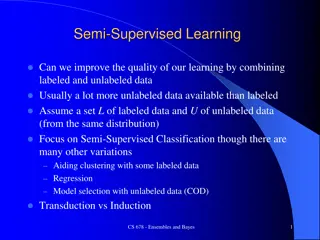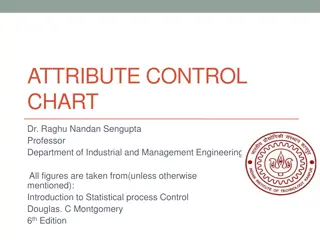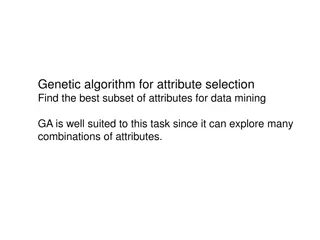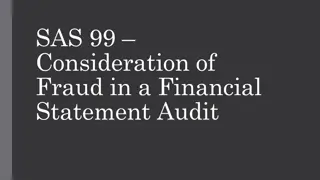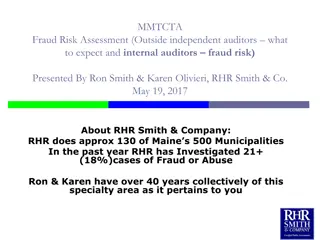Semi-Supervised Credit Card Fraud Detection via Attribute-Driven Graph Representation
Explore a novel approach for detecting credit card fraud using a semi-supervised attribute-driven graph representation. The technique leverages temporal aggregation and attention layers to automatically unify heterogeneous categorical attributes and detect fraudulent transactions without label leakage. The method involves generating temporal transaction graphs and attribute embedding to enhance fraud detection accuracy in real-world scenarios.
- Credit card fraud
- Graph representation
- Semi-supervised learning
- Temporal aggregation
- Attribute embedding
Download Presentation

Please find below an Image/Link to download the presentation.
The content on the website is provided AS IS for your information and personal use only. It may not be sold, licensed, or shared on other websites without obtaining consent from the author. Download presentation by click this link. If you encounter any issues during the download, it is possible that the publisher has removed the file from their server.
E N D
Presentation Transcript
Semi-supervised Credit Card Fraud Detection via Attribute-driven Graph Representation Sheng Xiang1, Mingzhi Zhu2, Dawei Cheng2, Enxia Li1, Ruihui Zhao3 , Yi Ouyang3, Ling Chen1, Yefeng Zheng3 1 The University of Technology Sydney, 2 Tongji University, 3 Tencent Jarvis Lab AAAI 2023 UTS CRICOS 00099F
Content Background. Method. Experiments. Conclusion and Future Work
Content Background. Method. Experiments. Conclusion and Future Work
Background Credit Card Fraud 30 billion US dollars in 2022
Background Framework of Credit Card Fraud Detection
Background Observations from Real-world Fraud Transactions Attribute Card Type Attribute Channel id Currency id Attribute Mchnt Type Term type Expensive Annotation Categorical Attributes
Background Framework of Credit Card Fraud Detection Previous Rule-based methods Machine learning-based methods require manually construct features Our Proposed model Automatically unify heterogeneous categorical attributes through feature learning Use the features and labels to detect fraud transactions without label leakage Temporal aggregation using temporal graph attention layer
Content Background. Method. Experiments. Conclusion and Future Work
Method Main architecture of GTAN
Method Temporal transaction graph generation Step 1: obtaining the time stamp of each transaction preprocessing the time attributes. Step 2: the chronological order of transactions per user is determined according to time stamps. Step 3: Connecting the edges whose target transaction time stamp is greater than the source transaction s, and repeat step 3 for each user.
Method Attribute Embedding 1) 2) Attr is the attribute. cat is the categorical attribute.
Method Gated Temporal Attention Networks Temporal attention mechanism 3) 4) 5) Gated residual mechanism 6) 7)
Method Fraud Detection and Optimization Risk propagation and fraud detection Masking to avoid label leakage
Content Background. Method. Experiments. Conclusion and Future Work
Experiments Dataset Dataset statistics We contribute a new large-scale partially labeled credit card fraud detection dataset to the research community, namely Finacial Fraud Semi-supervised Dataset (FFSD). Besides, we also experimented on two public supervised fraud detection datasets. The YelpChi graph dataset and Amazon graph dataset.
Experiments Compared methods Evaluating metrics Baseline Methods. State-of-the-art methods: Three popular metrics: GEM. GraphConsis Averaged precision (AP) FdGars. CARE-GNN Area under curve (AUC) Player2Vec. PC-GNN F-score GraphSAGE. Semi-GNN
Experiments Comprehensive Comparison
Experiments The result of semi-supervised experiments with different ratios of labeled training data
Experiments Ablation Study In the GTAN-A model, we remove the TGAT component, and the central node aggregates messages directly collected from neighboring nodes. In the GTAN-R model, we remove the risk embedding component and only use the original node attributes. Removing either component deteriorates the performance of GTAN, which proves that the temporal graph attention mechanism and risk embedding are both effective in graph-based fraud detection.
Content Background. Method. Experiments. Conclusion and Future Work
Conclusion We propose a semi-supervised graph learning framework to effectively model the risk propagation among transactions for fraud detection. We design a temporal graph neural network model to learn the transaction representations by attention mechanism and gated residual mechanism. Our proposed GTAN is interpretable and can be easily implemented in the industry-level system. Extensive experiments on both the financial fraud detection dataset and public fraud detection datasets demonstrate the superior performance of our proposed methods.
Thank you! Sheng Xiang, University of Technology Sydney. Sheng.xiang@student.uts.edu.au UTS CRICOS 00099F
Semi-supervised Credit Card Fraud Detection via Attribute-driven Graph Representation Sheng Xiang1, Mingzhi Zhu2, Dawei Cheng2, Enxia Li1, Ruihui Zhao3 , Yi Ouyang3, Ling Chen1, Yefeng Zheng3 1 The University of Technology Sydney, 2 Tongji University, 3 Tencent Jarvis Lab AAAI 2023 UTS CRICOS 00099F





